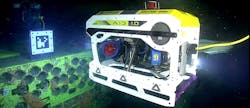Forssea drones inspecting subsea pipelines, offshore wind structures
FORSSEA ROBOTICS continues to pursue developments in autonomous subsea inspections. Last summer the company and DeepOcean tested an autonomous inspection drone (AID) in 400 m (1,312 ft) water depth in the Norwegian Sea, for a survey of subsea templates at the AkerBP-operated Skarv field. Forssea developed the software that allows the vehicle to operate in dynamic positioning, auto-docking, path-following and object-tracking modes. Its inspection path for the trial was pre-programmed using DeepOcean’s 3D Mission Planner.
According to Forssea, configuring the AID to accurately repeat an inspection path over subsea equipment leads to improved analysis of conditions for integrity management. Also, by allowing for simultaneous work during subsea operations, tasks can be performed more efficiently, with a reduction in the number of days required for offshore operations and lower intervention costs.
The company is collaborating with Vallourec and iXblue on an offshore pipeline inspection development. Conventionally this task would involve use of a surface vessel with acoustic positioning to monitor the deployment of AUVs or ROVs collecting data on the pipelines’ general condition, anode consumption, free span and burial areas by means of observation sensors. The partners developed an alternative solution that employs visual markers directly integrated onto the subsea pipelines, facilitating vessel-free subsea navigation. The barcodes placed on the pipe sections allow numerous passive positioning references to be logged with their own coordinates, and these should remain accessible throughout the field’s life. To ensure the markers remain visible to subsea drones and divers, they are designed for long-term resistance to marine growth and erosion. Successful trials have been conducted on 6-in. diameter pipes offshore southern France.
Forssea has secured a EUR3.8-million ($4.17-million) grant to finance the manufacture and deployment of the company’s ARGOS ROVs for long-term leases with maritime service companies. The program includes another collaboration with iXBlue involving the latter’s DriX surface drone, and the formation of a research team with France’s National Institute for Ocean Science, Ifremer (a shareholder in Forssea). ARGOS, supervised remotely, can dive to a water depth of up to 500 m (1,640 ft) to perform autonomous inspections of structures such as wind turbine foundations and anchor chains, or for tracking of subsea cables.
Finally, the company has another grant for R&D to enhance its light intervention ROV remote supervision capacity and deployment from a crew transfer vessel or unmanned surface vessel (USV), via a series of hardware and software upgrades. The key focus is on subsea inspections for offshore wind farm operations and maintenance purposes. “We believe that the home for the resident ROV is not the seabed but the USV,” said Forssea CEO Gautier Dreyfuss.
